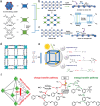Organic Donor-Acceptor Systems for Photocatalysis
- PMID: 38145342
- PMCID: PMC10933655
- DOI: 10.1002/advs.202307227
Organic Donor-Acceptor Systems for Photocatalysis
Abstract
Organic semiconductor materials are considered to be promising photocatalysts due to their excellent light absorption by chromophores, easy molecular structure tuning, and solution-processable properties. In particular, donor-acceptor (D-A) type organic photocatalytic materials synthesized by introducing D and A units intra- or intermolecularly, have made great progress in photocatalytic studies. More and more studies have demonstrated that the D-A type organic photocatalytic materials combine effective carrier separation, tunable bandgap, and sensitive optoelectronic response, and are considered to be an effective strategy for enhancing light absorption, improving exciton dissociation, and optimizing carrier transport. This review provides a thorough overview of D-A strategies aimed at optimizing the photocatalytic performance of organic semiconductors. Initially, essential methods for modifying organic photocatalytic materials, such as interface engineering, crystal engineering, and interaction modulation, are briefly discussed. Subsequently, the review delves into various organic photocatalytic materials based on intramolecular and intermolecular D-A interactions, encompassing small molecules, conjugated polymers, crystalline polymers, supramolecules, and organic heterojunctions. Meanwhile, the energy band structures, exciton dynamics, and redox-active sites of D-A type organic photocatalytic materials under different bonding modes are discussed. Finally, the review highlights the advanced applications of organic photocatalystsand outlines prospective challenges and opportunities.
Keywords: D-A interactions; exciton dissociation; organic semiconductors; photocatalysis.
© 2023 The Authors. Advanced Science published by Wiley-VCH GmbH.
Conflict of interest statement
The authors declare no conflict of interest.
Figures





















Similar articles
-
Nanoporous and nonporous conjugated donor-acceptor polymer semiconductors for photocatalytic hydrogen production.Beilstein J Nanotechnol. 2021 Jun 30;12:607-623. doi: 10.3762/bjnano.12.50. eCollection 2021. Beilstein J Nanotechnol. 2021. PMID: 34285864 Free PMC article. Review.
-
Advancing Electrically Conductive Metal-Organic Frameworks for Photocatalytic Energy Conversion.Acc Chem Res. 2024 Aug 20;57(16):2316-2325. doi: 10.1021/acs.accounts.4c00280. Epub 2024 Aug 7. Acc Chem Res. 2024. PMID: 39110102
-
Band-structure tunability via the modulation of excitons in semiconductor nanostructures: manifestation in photocatalytic fuel generation.Nanoscale. 2023 Jul 6;15(26):10939-10974. doi: 10.1039/d3nr02116e. Nanoscale. 2023. PMID: 37337832 Review.
-
Multinary I-III-VI2 and I2-II-IV-VI4 Semiconductor Nanostructures for Photocatalytic Applications.Acc Chem Res. 2016 Mar 15;49(3):511-9. doi: 10.1021/acs.accounts.5b00535. Epub 2016 Feb 11. Acc Chem Res. 2016. PMID: 26864703
-
A Mini Review on the Development of Conjugated Polymers: Steps towards the Commercialization of Organic Solar Cells.Polymers (Basel). 2022 Dec 29;15(1):164. doi: 10.3390/polym15010164. Polymers (Basel). 2022. PMID: 36616512 Free PMC article. Review.
Cited by
-
A dual-engineered covalent organic framework with charge-oxygen synergy promotes photocatalytic dipolar [3 + 2] cycloaddition.Chem Sci. 2025 Aug 27. doi: 10.1039/d5sc04639d. Online ahead of print. Chem Sci. 2025. PMID: 40918727 Free PMC article.
-
Donor-acceptor type covalent organic frameworks: design, optimization strategies and applications.Chem Sci. 2025 Jun 24;16(28):12768-12803. doi: 10.1039/d5sc01267h. eCollection 2025 Jul 16. Chem Sci. 2025. PMID: 40620347 Free PMC article. Review.
-
Nature of Charge Transfer Effects in Complexes of Dopamine Derivatives Adsorbed on Graphene-Type Nanostructures.Int J Mol Sci. 2024 Sep 29;25(19):10522. doi: 10.3390/ijms251910522. Int J Mol Sci. 2024. PMID: 39408851 Free PMC article.
-
Self-assembled π-conjugated chromophores: preparation of one- and two-dimensional nanostructures and their use in photocatalysis.Nanoscale. 2024 May 16;16(19):9153-9168. doi: 10.1039/d4nr00383g. Nanoscale. 2024. PMID: 38639760 Free PMC article. Review.
-
D1-A-D2 Conjugated Porous Polymers Provide Additional Electron Transfer Pathways for Efficient Photocatalytic Hydrogen Production.Molecules. 2025 May 16;30(10):2190. doi: 10.3390/molecules30102190. Molecules. 2025. PMID: 40430361 Free PMC article.
References
-
- Miao Y., Zhao Y., Zhang S., Shi R., Zhang T., Adv. Mater. 2022, 34, 2200868. - PubMed
-
- He T., Zhao Y., Angew. Chem., Int. Ed. 2023, 62, 202303086.
-
- Sun X., Huang H., Zhao Q., Ma T., Wang L., Adv. Funct. Mater. 2020, 30, 1910005.
-
- He J., Liu Y., Qu J., Xie H., Lu R., Fan F., Li C., Adv. Mater. 2023, 35, 2210374. - PubMed
-
- Gong E., Ali S., Hiragond C. B., Kim H. S., Powar N. S., Kim D., Kim H., In S.‐I., Energy Environ. Sci. 2022, 15, 880.
Publication types
Grants and funding
LinkOut - more resources
Full Text Sources
